Marrying Vega and Zen: The AMD Ryzen 5 2400G Review
by Ian Cutress on February 12, 2018 9:00 AM ESTiGPU Gaming Performance, Continued
Rise of the Tomb Raider
One of the most comprehensive games in the gaming benchmark suite is Rise of the Tomb Raider (RoTR), developed by Crystal Dynamics, and the sequel to the popular Tomb Raider which was loved for its automated benchmark mode. But don’t let that fool you: the benchmark mode in RoTR is very much different this time around.
Visually, the previous Tomb Raider pushed realism to the limits with features such as TressFX, and the new RoTR goes one stage further when it comes to graphics fidelity. This leads to an interesting set of requirements in hardware: some sections of the game are typically GPU limited, whereas others with a lot of long-range physics can be CPU limited, depending on how the driver can translate the DirectX 12 workload.

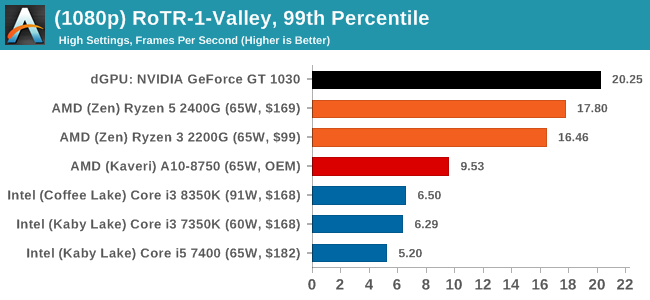
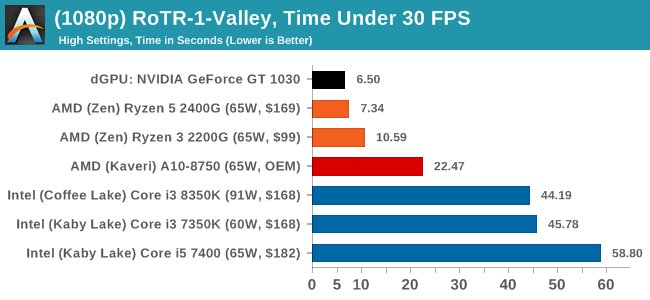
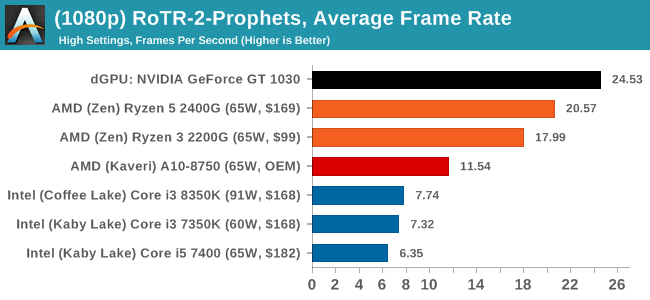
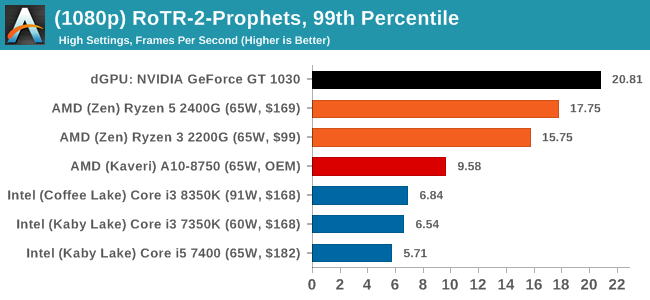
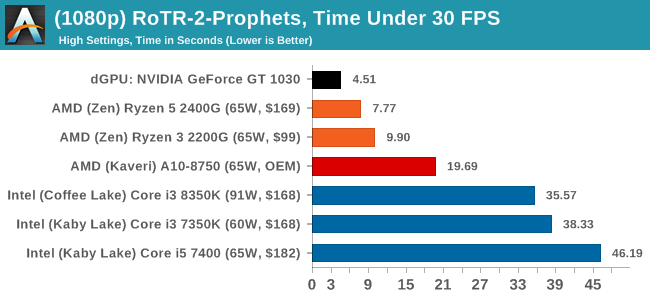

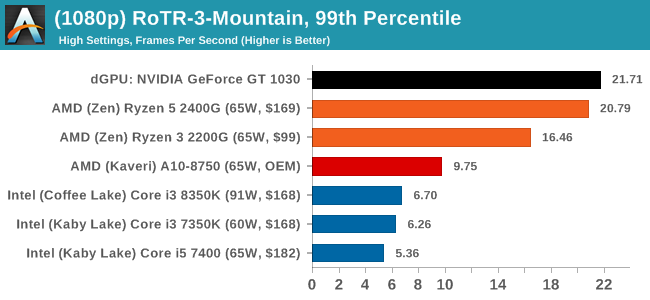
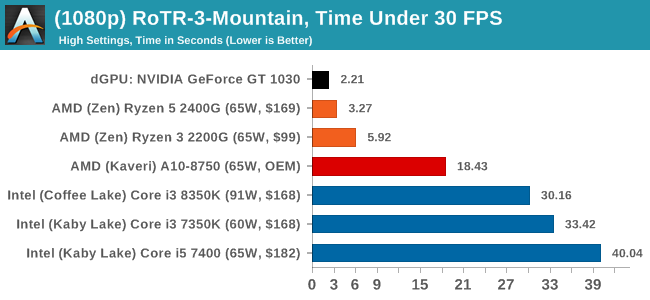
The GT 1030 sweeps the top spot against AMD here, though only by small margins most of the time. The AMD APUs still offer a commanding 2-3x performance jump over Intel's product line, and even more when price is factored into the equation.
Rocket League
Hilariously simple and embodying the elements of pick-up-and-play, Rocket League allows users to jump into a game with other people (or bots) to play football with cars with zero rules. The title is built on Unreal Engine 3, which is somewhat old at this point, but it allows users to run the game on super-low-end systems while still taxing the big ones. Since the release in 2015, it has sold over 5 million copies and seems to be a fixture at LANs and game shows. Users who train get very serious, playing in teams and leagues with very few settings to configure, and everyone is on the same level. Rocket League is quickly becoming one of the favored titles for e-sports tournaments, especially when e-sports contests can be viewed directly from the game interface.
With Rocket League, there is no benchmark mode, so we have to perform a series of automated actions, similar to a racing game having a fixed number of laps. We take the following approach: Using Fraps to record the time taken to show each frame (and the overall frame rates), we use an automation tool to set up a consistent 4v4 bot match on easy, with the system applying a series of inputs throughout the run, such as switching camera angles and driving around.
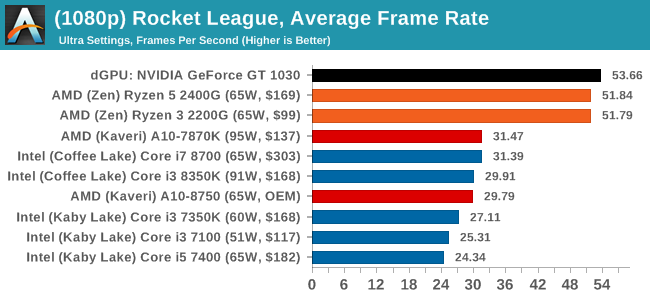
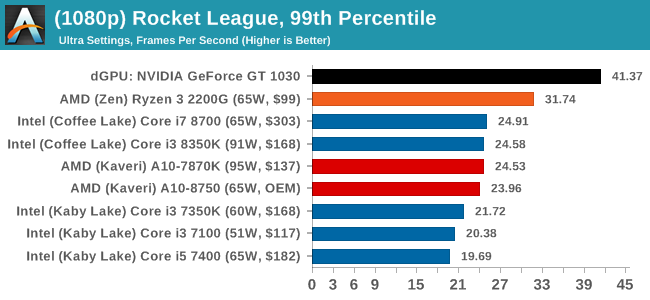

As the more eSports oriented title in our testing, Rocket League is less graphically intense than the others, and by being built on DX9, also tends to benefit from a good single thread performance. The GT 1030 wins again here, most noticably in the 99th percentile numbers, but the AMD chips are hitting 30 FPS in that percentile graph, whereas in the last generation they were getting 30 FPS average. That is a reasonable step up in performance, aided both to the graphics and the high-performance x86 cores. It will be interesting to see how the memory speed changes the results here.










177 Comments
View All Comments
Hurr Durr - Monday, February 12, 2018 - link
I don`t care about these. I want to see how AMD is holding up in notebooks, 15W range specifically.Hul8 - Monday, February 12, 2018 - link
For a low-end graphics part like this, it would be really interesting to have a section in the review exploring the "comfortable" settings in various games.It could be really useful information for potential buyers to know what kind of settings they'd need to run in a game to reach their preferred performance level (99th percentile), whether it's 30, 45 or 60 fps, and also to know if a product simply can't reach certain performance no matter how low you turn the settings.
DrizztVD - Monday, February 12, 2018 - link
Why do you only report total power consumption? I'd like to see power efficiency!!! Since I don't know what the performance per CPU is, these power measurements mean almost nothing. Also, the efficiency will change with the workload, so Prime95 is a very one-dimensional test of efficiency. Look at your power measurement graphs: they tell you what we already know - single core speeds are lower for Ryzen, and lower TDP CPUs use less power. That's kinda duh...JHBoricua - Monday, February 12, 2018 - link
I'm confused. The AMD vs. AMD section led me to believe there was going to be a comparison of Raven Ridge against Bristol Ridge APUs, which makes sense as it would have allow the use of the same motherboard for both APUs, even if the Bristol Ridge DDR4 memory was clocked slower. But then actual benchmarks is showing Kaveri parts?prtskg - Tuesday, February 13, 2018 - link
Kaveri was better at gaming/performance than Bristol. The latter had the advantage of efficiency.nwarawa - Monday, February 12, 2018 - link
Comparing with a competitive Intel platform with dGPU is kinda tricky right now. It's not just the dGPUs that are ridiculously priced right now. RAM is too. And to maximize performance on the R7 2400G, you WILL need to spend more than the basic $90 8GB 2400 kit. The cheapest 16GB Samsung b-die 3200 kit I found was $220. And you will want to go with a 16GB kit, because already some newer games use more than 8GB, and they use MORE when using graphics cards with less than 4GB. The iGPU takes some of that 8GB for itself...if runs out of system RAM, it has to use your system disk... enjoy the single digit frame rates...Here is what I found on newegg:
INTEL
$130 - i3-8100
$90 - 8GB 2400 RAM (or 170 for 16GB)
$120 - Z370 motherboard (no mainsteam chipset YET)
===
$340
AMD
$170 - R5 2400g
$220 - 16GB 3200C14 RAM
$80 - Motherboard(cheapest decently reviewed AM4)
===
$470
The intel system is a full $130 cheaper (or $50 if you spring for the 16GB), and that gap will only increase with the upcoming cheaper chipsets and/or upcoming coffee lake models. Now, I haven't included the dGPU yet, but the GTX1050 2GB currently goes for $150 - making the Intel system total only $20 more than than AMD system, and running rings around it in most games (although neither would be ideal for the latest games... the 2GB-GPU/8GB-SYSRAM Intel system would run out of memory and the Vega 11 just doesn't have the horsepower).
What would put things in favor of AMD would be if they made clear that the iGPU would still be of use when using a dGPU (such as with the new "ThueAudioNext") in the future.
What I would REALLY like to see, though, is AMD use the beefier Vega iGPUs Intel is using with their own 12nm Zen+ chips and slap on some HBM memory. THAT I could go for.
oleyska - Monday, February 12, 2018 - link
Jeez,1.\ HBM on budget chips pushes them into 250$ range by just adding HBM.
2.\ IGP solutions are not a GTX1060 replacement, it's not magic.
System comparison:
I3 8100 is inferior in cpu tasks.
it has half the memory (intel IGP still uses memory you know?, it's configurable on both systems.
The benchmarked system runs at 2933, not 3200 so o.0
it has inferior gpu 3X~
even at same memory speeds it would still be 2X as slow, slower cpu.
So what is the point of the argument ?
It not needed to have the extra memory frequency but if you want to replace a 80$ dedicated gpu you need to and definitely add 8gb extra memory and that's where the cost comes into place as a valid comparison if you subtract 20$ from AMD for 2933 ~
add 80-100$ for GT1030 you still end up with an intel rig with higher system power consumption, equal gaming performance, inferior cpu and you will have to buy a G-sync monitor if you want tearing free monitor while freesync is thrown at ya at any price range as an added bonus.
systems are comparable and Intel's I3 line is destroyed along amd's old R3 line too.
I5,I7 and R5 stands tall still and the R7 has it's place at times too.
nwarawa - Monday, February 12, 2018 - link
Did you not even read my post? Or the review for that matter? Did you think AT ALL about the real life application of anything said before posting? "I3 8100 is inferior in cpu tasks" WHAT tasks? I'll answer that for you. Rendering. If you are trying to get the cheapest CPU possible for rendering with as little RAM as possible to shave as much money off as possible... you are doing it wrong. Since we (or at least I am... not sure what you are going on about) are talking about GPUs, you can safely assume we are concerned about GAMES."it has half the memory" no s--t, sherlock, read the post again (or for the first time, apparently)
I could go on, but apparently you were just scouring the posts for someone to disagree with with a pre-defined little rant, so I won't bother.
Fritzkier - Monday, February 12, 2018 - link
Why you need 16GB? if you bought Ryzen APU, you probably only plays e-sport title anyway and some older games... E-sport titles doesn't need a huge RAM. And it already crush the intel counterparts, both in performance and price.You guys from first world countries are always complaining. Jeez. Try to live at poorer countries like South East Asia.
serendip - Tuesday, February 13, 2018 - link
An APU at $100 would still be expensive, especially when people in the developing world build machines with Pentium G chips. The speedy APU graphics would negate the need for a low-end discrete GPU though.